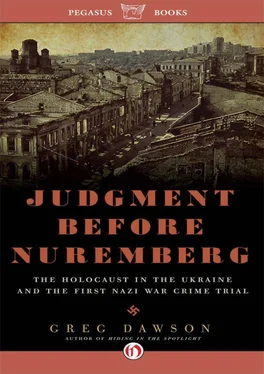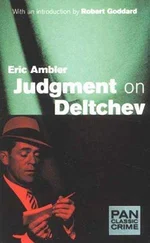There is little reason to believe that Dmitri Arshansky, his wife, Sara, and his parents eluded this fate. My mother and her sister are the only known survivors of the march from the tractor factory to Drobitsky Yar. After a few minutes, I began my slow ascent, climbing out of the grave step by step. My cell phone rang—it was Candy. “Are you okay?” Never had her voice sounded sweeter.
Irina was waiting for me in the office with hot tea and cookies. I had arranged for the same taxi that dropped me at the ghetto site to pick me up at noon at Drobitsky Yar and take me back to Kharkov for my next appointment. Something must have been lost in translation—he never showed up or called. Around one o’clock, Irina got on the phone and had an animated conversation with someone she obviously knew well. She hung up and said, in English, “We walk… to road.”
Emotionally spent, I was in no position to argue. We put on our coats and headed out the door. The snow had stopped and a worker was shoveling the broad walkway in front of the memorial arch. Irina, in spiky heels worn by all Ukrainian women in all weather and all terrains, led me back to the winding road. We were marching out of Drobitsky Yar. I looked back at the ravines, vanishing into the landscape like fugitives.
We reached the highway, and Irina motioned me over to one side. “We wait,” she said. Behind us was the nine-foot menorah marking the entrance to Drobitsky Yar. I went over for a last look and read the inscription again. “This is the place where the dead teach the living ones.” I placed four stones at the base of the menorah in memory of my grandparents and great-grandparents whose bones lie beneath these strawberry fields.
After a few minutes, a little car turned off the highway and pulled up in front of us. A smiling man, Irina’s friend, opened the door and we climbed in. On the way back to Kharkov, I thought about my trip to the bottom of the ravine, and wondered what the dead ones had been trying to teach me.
Since the British packed their wigs and red coats and went home more than two hundred years ago, no foreign army has occupied American soil. Before 9/11, no foreign enemy had struck a city on the U.S. mainland and left thousands dead—though residents of Atlanta during the Civil War would beg to differ. The markers of that conflict are generally found in the countryside at places like Shiloh and Gettysburg and Chickamauga.
In Kharkov, as in other cities in Ukraine, the evidence of foreign occupation and destruction in our lifetime is around every corner in the commercial district—places of torture, imprisonment, and the banal bureaucracy of terror. Some are memorialized with plaques, others are unmarked. High-fashion mannequins in a store window on Sumskaya Street belie the building’s past as Gestapo headquarters during the occupation.
Yuri Radchenko knows them all. Born in Kharkov in 1986, he grew up in Severnaya Saltkova, a vast housing development north of the city. Sprouting to 6-6, Yuri’s first passion was basketball. He found his next calling at the age of fifteen at a park where the Nazis slaughtered 4,000 residents of Kharkov, many of them Jews. His interest in this period of Kharkov’s history grew into a lifelong fascination. He wrote a thesis on Soviet prisoners of war in Nazi Germany and occupied Europe while at V.N. Karazin Kharkov National University. In 2010, he was a post-graduate student completing a dissertation on the Holocaust in Kharkov and eastern Ukraine when he first responded to my e-mail to the history department requesting information for this book about the Holocaust in Ukraine, specifically Kharkov, and the Kharkov trial.
“Of course I want to help in your project,” Yuri wrote. “It is our common duty to remember tragic past of the Holocaust. If you will visit Kharkov, I can be your guide—I have some experience. You must know that Jews were killed not just in Drobitsky Yar, synagogue and ghetto. Many Jewish were exterminated in Sokolniky Park and two prisons of SD (SS security and intelligence service).”
We met on a snowy Friday morning in mid-December outside School 13 where earlier I had addressed—with massive help from the school’s English teacher—students the same age as my mother when she’d attended the school seventy years before. Yuri had engaged a cabbie he knew, Sergy, and his sardine-can compact. I climbed in the front, Yuri folded himself into the back, and we were off through the partly plowed streets of Kharkov. Lean and rangy, Yuri has the metabolism of a greyhound and a hyperkinetic intellect. He speaks Ukrainian, Russian, English, German, and Yiddish—sometimes all at once—and soon will add Hebrew to his crowded tower of Babel.
“Now we are going to visit ex-stalag, prisoner of war camp for Soviet prisoners, which was functioning from 1941 to 1943,” Yuri said. “It is on Holodnaya Gora—meaning cold hill. Sources say 10,000 Soviet prisoners died here. We don’t know exactly the reason why they died. Starvation, disease—another, another, another. Commanders of SD in Kharkov didn’t know how to bury these bodies, so they decide to bury them in Drobitsky Yar. It has very big graves, you know. They decided to do it after the mass shootings there. The prisoners were buried with some patients from mental hospital No. 15. There is no information at Drobitsky Yar about these other murders.”
We stood in swirling snow outside the long, faceless building, painted a bilious yellow, with old-school barbedwire—not razor wire—strung along the tops of walls. It had always been a prison, Yuri said, from the time of the Russian empire to Soviet Ukraine, during the Nazi occupation, and now again. “They have museum inside,” he said. “But is very hard to come inside. You must prepare many documents, many papers. And there is nothing, no signification, that here died Soviet prisoners of war.”
We clambered back into the welcome warmth of Sergy’s cab. “Now, Greg, we are going to visit ex-S.D. prison, the first Jewish camp in Kharkov,” Yuri said, and a wildly inappropriate memory suddenly intruded. I had done something like this before. On one of my trips to Hollywood as a television critic, I took the legendary “Grave Line Tour” of celebrity death sites, riding upright in the back of a silver hearse. Unlike the Jews of Kharkov, most of these celebrities—Marilyn Monroe, John Belushi, George Reeves (Superman), among others—died by their own hand. An exception was Sharon Tate, pregnant wife of movie director Roman Polanski, who was slaughtered with three friends in her Hollywood Hills home by Charles Manson and his enthralled acolytes who later argued they were only following orders. It was almost as if Hitler had loosed a million Manson families on Ukraine.
The cab turned down a narrow side street and pulled up at the curb. I glanced up and down Rybnaya Street at a mélange of storefronts and saw nothing of obvious historical import. Yuri pointed to a brown retractable door like those on a garage. This is the first place the Nazis imprisoned Jews, Yuri said.
“It was created in November ’41 and existed till December 1941. Maybe 300 or 500 Jews were held here. In this camp Germans exploited Jews, there was forced labor here. They killed one Jew, an old man. They hanged him in the garage. In this garage were the so-called Gaswagens used to kill Jews.” The mobile units were the precursors to the gas chambers at Auschwitz, Sobibor, Treblinka, and other death camps.
In his research Yuri discovered the names of six Russian and Ukrainian collaborators who drove these gaswagens and worked out of this garage, cleaning and maintaining the death vans between assignments. Only one, Michael Bulanov, was captured, and later stood trial with three Nazi officers. The garage was used as a prison for a month, until the Nazis created a larger ghetto at the tractor factory southeast of the city—on the road to Drobitsky Yar.
Читать дальше












